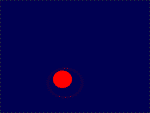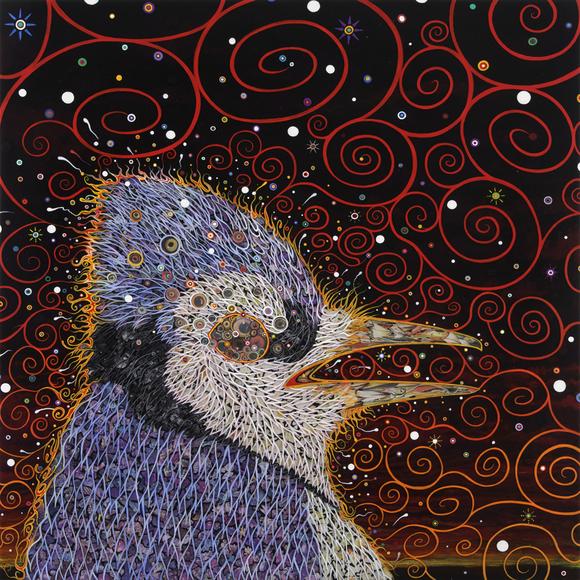
-- A Cyberspace Review Of The Arts
Volume 18.06
June 8, 2011
|
Alchemy & Inquiry by Donna Maria deCreeft
Wave Hill, with its botanical gardens and transcendental views of the Hudson, is the perfect venue for this fascinating exhibition by Philip Taaffe, Fred Tomaselli and Terry Winters. Sharing the idea of artist as magus or shaman, Taaffe, Tomaselli and Winters each manifest something unique about the Anima Mundi, or soul of the world. They manage to encompass and encode a long tradition of humanism in their work within individual stylistic techniques, uses of media and decorative patterning. The keys to their code are found in the connections between science and nature in terms of the microcosm and the macrocosm, the archetypal symbolism of the alchemical process, and the fractal dimension of Chaos theory. Alchemy, as both protoscience and hermetic philosophy, is a transformative practice based on the neo-platonic idea of "as above, so below." Intrinsic to the discipline is an intuitive and experiential understanding of the way the patterns of nature are repeated throughout the universe in large and small scale. The actual steps in the metallurgical refining process are reflected in the allegorical search for the "Philosopher's Stone", a legendary substance that once discovered transmutes the base metal of the soul into the gold of enlightenment. This metaphysical aspect of alchemy suggests that humans are psychologically permeable in relation to the natural world, continually shifting between the microcosmic self and the macrocosmic universe. Experiencing the shift between the two states leads to a kind of cosmic consciousness.
Fred Tomaselli's work embodies this permeability. In "Dahlia," Tomaselli embeds collaged photographs in the primary layer of his canvas. Using combinations of plants and animals as metaphors for the elements, he suggests the alchemical Prima Materia, or cosmic soup from which all things emanate. A layer of resin separates these images from the intricate surface painting. His mandala-like central figure is surrounded with fire: the transformative, purifying element in Hindu spiritual philosophy and the crux of the alchemical process. In "The Dust Blows Forward, The Dust Blows Back," the eye of the blue jay is a peephole through the painted illusion. With his complex layering technique and psychedelic imagery built from elemental patterns and vibrating colors, Tomaselli allows us to view nature through what Aldous Huxley, the visionary writer, called "the doors of perception." In Chaos theory, the experiential and the intuitive, micro and macro, are also mirrored. When William Blake saw the universe in a grain of sand he may well have been referring to the alchemical concept of "as above, so below." And, it is not a stretch to think he was anticipating the iterations that abound in Philip Taaffe's work.
Taaffe's motifs are anchored in nature and cross-fertilized by a variety of traditions. He uses ornamental patterns derived from Islamic and Celtic art, and marbling, a decorative process that made its way into alchemical lore from Asia through the art of papermaking. In one of his unabashedly decorative compositions, the vivid "Cereus Chrysocentrus," he embeds the chaotic concepts of iteration and flow. Taaffe's repeating abstract patterns based on cacti are combined with the physics of fluid mechanics as demonstrated in marbling.
Iteration also appears in 'After Alcyonaria,' one of a series of richly colored silk-screens that incorporate reproductions of land and sea forms from 19th- and 20th-century natural histories. The similarity of the fractal growth patterns in these forms reveals Taaffe's understanding of the underlying modalities of the biological world. Alchemy links up with Chaos theory through sacred geometry and the mystical significance of the six-pointed star. Formed by two conjoined triangles, this ancient symbol represents the generative force, the elements--earth, water, air and fire, and the reconciliation of opposites that imply limitation and limitlessness. "Koch's Snowflake" is a fractal image inherent in the mathematics of nature. Its infinite iterations, produced through the advanced technology of computer processing, also begin with a six-pointed star, which brings us in the way of free association to Terry Winters' "Pollen" series.
The uncharacteristic decorative quality of Winters' embossed relief prints is purposeful. Again, the principles of idea and image reinforce each other. At first glance the intricate spherical patterns might be snowflakes or lace, but closer inspection of the central images reveal floral forms. The prints have a grainy surface, like pollen, and the function of the pollen is generation. Once it becomes clear that the fundamental structure of each composition is based on the hexagram, the fractal and alchemical code for procreation--a signifier of a universe of being and becoming, the levels of meaning begin to multiply.
This is a heady show conceptually. The beauty of nature at Wave Hill, as seen through the Glyndor Gallery windows, illuminates and reflects the artwork. The delightful visual pleasures of the exhibition serve the serious thought behind it well, and the profound connection between art and science that is the humanist through-line is firmly established by all involved. It's worth taking a look at the artists' websites to get a better understanding of their ideas. Peter Lamborn Wilson and Wave Hill curator, Jennifer McGregor, also provide a way in to the artists' collective spirit of inquiry through their excellent catalogue essays. |
|||
|
|
|||
|
|
|||
|
Donna Maria deCreeft / 2011 |
|||







 Back to the Front
Back to the Front